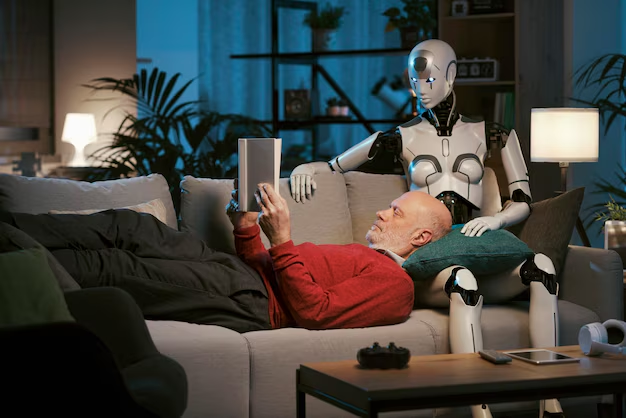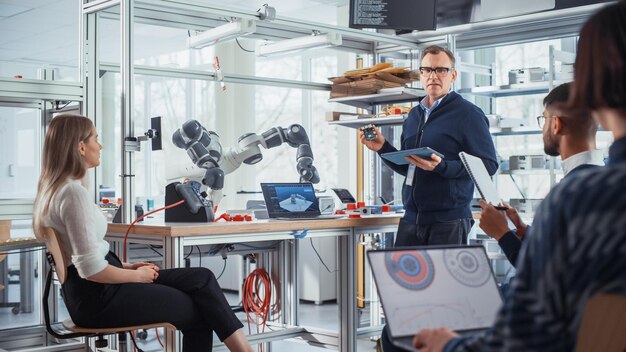The world is at the cusp of a technological revolution, with robotics taking center stage in transforming industries and our everyday lives. From industrial automation to personal assistance, robotics is redefining the way we work, interact, and live. In this article, we will explore how robotics is shaping the future of industries, improving productivity, and Future Of Robotics enhancing personal experiences, making a significant impact on society as a whole.
1. The Evolution of Robotics: From Concept to Reality
Robots have come a long way since their conceptualization in science fiction. Today, robotics technology is an integral part of multiple industries, driving innovation and automation. With advances in artificial intelligence (AI), machine learning, and autonomous systems, robots are now capable of performing complex tasks with remarkable precision and efficiency.
Key Milestones in Robotics:
- Early Robotics: Robots like Unimate, the first industrial robot, were created to perform repetitive tasks in manufacturing plants.
- The Rise of Autonomous Robots: The development of self-learning robots that can navigate and make decisions without human input has opened doors to new possibilities.
- Collaborative Robots (Cobots): Cobots are designed to work alongside humans, improving productivity while ensuring safety and flexibility in the workplace.
2. Transforming Industries: How Robotics is Revolutionizing Key Sectors
Robotics is having a profound impact on various industries, with advancements leading to increased productivity, cost-efficiency, and safety. Let’s dive into how robotics is revolutionizing key sectors:
Manufacturing Industry:
In manufacturing, robots have become the backbone of production lines, handling everything from assembly to quality control. The ability of robots to perform tasks with precision has resulted in faster production times, lower error rates, and enhanced consistency.
- Robotic Arms: Widely used for assembly, welding, painting, and material handling.
- Automation and Flexibility: Robots can adapt to different production runs, ensuring greater flexibility in the manufacturing process.
Healthcare Industry:
The integration of robotics in healthcare has improved the quality of patient care, reduced human error, and increased operational efficiency. Robotic surgery, rehabilitation robots, and robotic assistants are reshaping healthcare practices.
- Robotic Surgery: Precision tools like the da Vinci Surgical System allow surgeons to perform minimally invasive procedures with improved outcomes.
- Rehabilitation Robots: These devices assist patients with mobility issues, helping them regain independence and improve recovery.
Logistics and Transportation:
Robots are also transforming logistics and transportation. Autonomous vehicles, delivery drones, and robotic sorting systems are enhancing efficiency and reducing operational costs.
- Autonomous Trucks and Vehicles: Self-driving vehicles are revolutionizing freight transportation by reducing human intervention, improving efficiency, and cutting costs.
- Drones in Delivery: Companies like Amazon and UPS are investing in drones to expedite parcel deliveries, promising faster and more efficient logistics.
Retail Industry:
In retail, robots are enhancing customer service and streamlining supply chain operations. From inventory management to automated checkout systems, robots are making the shopping experience more efficient.
- Automated Checkout Systems: Robots and AI-driven systems are simplifying the checkout process, making transactions faster and reducing wait times.
- Robotic Stockers: Robots are helping restock shelves, ensuring that stores maintain inventory levels and improving product availability.
3. Robots in Everyday Life: Enhancing Convenience and Quality of Living

Beyond industries, robots are becoming an integral part of our personal lives. Whether in the form of smart home devices, personal assistants, or robots for elderly care, the benefits of robotics extend far beyond the workplace.
Smart Homes:
AI-powered robots are enhancing our homes by automating tasks such as cleaning, security, and energy management. These devices can perform actions autonomously, saving time and improving convenience for homeowners.
- Robotic Vacuum Cleaners: Devices like the Roomba can autonomously clean your home without human intervention, maintaining cleanliness and saving time.
- Smart Security Systems: Robots equipped with cameras and AI-powered sensors can monitor homes, providing increased security and peace of mind.
Personal Assistants:
From Amazon Alexa to Google Assistant, personal assistant robots are helping individuals manage daily tasks. These systems use natural language processing to interact with users, setting reminders, controlling home devices, or answering questions.
- Voice-Activated Assistance: These robots respond to voice commands, providing a hands-free experience for tasks like shopping, controlling lights, or playing music.
- Robot Helpers for the Elderly: Robots designed to assist older adults with mobility, medication reminders, and even companionship are improving the quality of life for seniors.
4. Artificial Intelligence and Robotics: Driving Innovation
The fusion of AI and robotics is creating smart machines that can learn from their environment, adapt to changes, and improve performance over time. AI enables robots to make autonomous decisions, navigate complex environments, and execute tasks without constant human supervision.
- Machine Learning and Robotics: Robots are able to learn from data and enhance their performance over time, making them more efficient and capable of handling more complex tasks.
- AI-Powered Automation: Combining AI with robotics can lead to fully automated processes, from manufacturing to customer service, increasing overall productivity and reducing human error.
5. Challenges and Ethical Considerations in Robotics
While the future of robotics is filled with potential, it also presents challenges and ethical concerns that must be addressed:
- Job Displacement: As robots take over more tasks traditionally performed by humans, there are concerns about the displacement of workers, especially in sectors like manufacturing and logistics.
- Privacy and Security: With robots collecting vast amounts of data, ensuring privacy and security is essential to protect individuals and organizations.
- Ethical Issues: As robots become more autonomous, questions about accountability, decision-making, and human-robot relationships will become more prominent.
6. The Future of Robotics: Endless Possibilities
Looking ahead, the role of robotics will continue to expand, creating new opportunities and challenges. The potential for robots to revolutionize industries and daily life is limitless. Here are some areas where robotics will continue to make an impact:
- Space Exploration: Robots will play a key role in exploring other planets, conducting research, and performing tasks that are too dangerous for humans.
- Human-Robot Collaboration: The future of work will involve more collaboration between humans and robots, where robots perform repetitive or dangerous tasks, leaving humans to focus on complex problem-solving and creativity.
- AI-Driven Innovations: As robots become smarter and more capable, their applications will extend into fields like education, entertainment, and even emotional support.
Also Read : Innovating The Future: The Role Of Robotics In Modern Society
Conclusion: Embracing the Future of Robotics
Robotics is revolutionizing industries, improving personal lives, and pushing the boundaries of technological innovation. As we move forward, it is crucial to embrace these advancements while addressing ethical concerns and ensuring that robots are used to benefit society as a whole. The future of robotics holds immense promise, and its impact will continue to be felt across all facets of our lives.
SEO Optimized Keywords:
- Future of robotics
- Role of robotics in modern society
- Robotics applications
- Artificial intelligence in robotics
- Robots in healthcare
- Robotics in manufacturing
- Smart robots
- Autonomous robots
- Robotics in everyday life
- Robotics and automation
- Robotics in transportation
- Robotic arms
- Collaborative robots
- Machine learning and robotics
- Robotics innovations
- AI-powered robots
- Robotics for home use
- Robotics in agriculture
- Ethical issues in robotics
- Job displacement and robotics
- AI-driven robots
- Robotics in space exploration
- Robotics trends
- Robots for elderly care
- Robotics in education
- Robotics in logistics
- Autonomous vehicles

